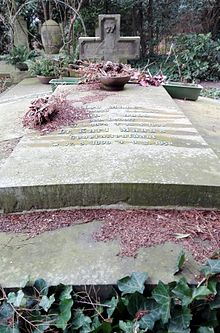Karl Mauss
This article has multiple issues. Please help improve it or discuss these issues on the talk page. (Learn how and when to remove these template messages)
|
Karl Mauss | |
|---|---|
Knight's Cross of the Iron Cross with Oak Leaves, Swords and Diamonds | |
| Other work | Dentist |
Karl Mauss (17 May 1898 – 9 February 1959) was a German general during
Career
Mauss volunteered for service in

At the start of the war, Mauss served with the 20th Motorized Infantry Division, with which he participated in the 1939 Invasion of Poland. In May 1940 his 10th Panzer Division took part in the Battle of France together with Heinz Guderian's XIX Army Corps. In the second phase of the campaign, Mauss participated in the battles against the French 7th Army.
Mauss took part in Operation Barbarossa, the invasion of the Soviet Union in June 1941. In November 1941, he was awarded the Knight's Cross of the Iron Cross. In 1942 Mauss was promoted to colonel; he was awarded the Oak Leaves to the Knight's Cross in November, 1943. In January 1944 he took command of the 7th Panzer Division. On 23 October 1944 he received the Knight's Cross with Oak Leaves and Swords. In February 1945 he was seriously injured and had a leg amputated. He was promoted to General der Panzertruppe in April, and received the Knight's Cross with Oak Leaves, Swords, and Diamonds on 15 April 1945.
After the war Mauss worked as a dentist in his own practice. He died in 1959 following a lengthy illness.
Awards
- Iron Cross (1914) 2nd Class (16 September 1915) & 1st Class (21 October 1916)[3]
- Clasp to the Iron Cross (1939) 2nd Class (28 September 1939) & 1st Class (25 May 1940)[3]
- German Cross in Gold on 11 March 1943 as Oberst in the Panzergrenadier-Regiment 33[4]
- Knight's Cross of the Iron Cross with Oak Leaves, Swords and Diamonds
- Knight's Cross on 26 November 1941 as Oberstleutnant and commander of the II./Schützen-Regiment 69[5]
- Oak Leaves on 24 November 1943 as Oberst and commander of the Panzergrenadier-Regiment 33[5]
- Swords on 23 October 1944 as Generalmajor and commander of the 7. Panzer-Division[5]
- Diamonds on 15 April 1945 as Generalleutnant and commander of the 7. Panzer-Division[5]
References
Citations
- ^ Fraschka 1994, p. 325.
- ^ Fraschka 1994, p. 326.
- ^ a b Thomas 1998, p. 64.
- ^ Patzwall & Scherzer 2001, p. 299.
- ^ a b c d Scherzer 2007, p. 531.
Bibliography
- Fraschka, Günther (1994). Knights of the Reich. Atglen, Pennsylvania: ISBN 978-0-88740-580-8.
- Patzwall, Klaus D.; Scherzer, Veit (2001). Das Deutsche Kreuz 1941 – 1945 Geschichte und Inhaber Band II [The German Cross 1941 – 1945 History and Recipients Volume 2] (in German). Norderstedt, Germany: Verlag Klaus D. Patzwall. ISBN 978-3-931533-45-8.
- Scherzer, Veit (2007). Die Ritterkreuzträger 1939–1945 Die Inhaber des Ritterkreuzes des Eisernen Kreuzes 1939 von Heer, Luftwaffe, Kriegsmarine, Waffen-SS, Volkssturm sowie mit Deutschland verbündeter Streitkräfte nach den Unterlagen des Bundesarchives [The Knight's Cross Bearers 1939–1945 The Holders of the Knight's Cross of the Iron Cross 1939 by Army, Air Force, Navy, Waffen-SS, Volkssturm and Allied Forces with Germany According to the Documents of the Federal Archives] (in German). Jena, Germany: Scherzers Militaer-Verlag. ISBN 978-3-938845-17-2.
- Stockert, Peter (1998). Die Eichenlaubträger 1939–1945 Band 4 [The Oak Leaves Bearers 1939–1945 Volume 4] (in German). Bad Friedrichshall, Germany: Friedrichshaller Rundblick. ISBN 978-3-932915-03-1.
- Thomas, Franz (1998). Die Eichenlaubträger 1939–1945 Band 2: L–Z [The Oak Leaves Bearers 1939–1945 Volume 2: L–Z] (in German). Osnabrück, Germany: Biblio-Verlag. ISBN 978-3-7648-2300-9.
